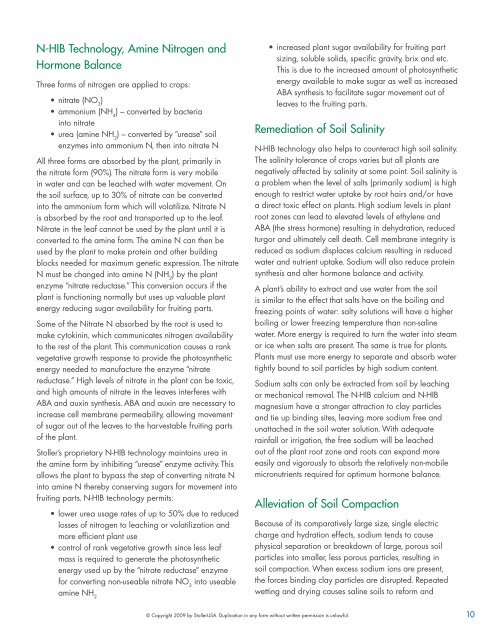You also want an ePaper? Increase the reach of your titles
YUMPU automatically turns print PDFs into web optimized ePapers that Google loves.
N-HIB Technology, Amine Nitrogen and<br />
Hormone Balance<br />
Three forms of nitrogen are applied to crops:<br />
• nitrate (NO 3 )<br />
• ammonium (NH 4 ) – converted by bacteria<br />
into nitrate<br />
• urea (amine NH 2 ) – converted by “urease” soil<br />
enzymes into ammonium N, then into nitrate N<br />
All three forms are absorbed by the plant, primarily in<br />
the nitrate form (90%). The nitrate form is very mobile<br />
in water and can be leached with water movement. On<br />
the soil surface, up to 30% of nitrate can be converted<br />
into the ammonium form which will volatilize. Nitrate N<br />
is absorbed by the root and transported up to the leaf.<br />
Nitrate in the leaf cannot be used by the plant until it is<br />
converted to the amine form. The amine N can then be<br />
used by the plant to make protein and other building<br />
blocks needed for maximum genetic expression. The nitrate<br />
N must be changed into amine N (NH 2 ) by the plant<br />
enzyme “nitrate reductase.” This conversion occurs if the<br />
plant is functioning normally but uses up valuable plant<br />
energy reducing sugar availability for fruiting parts.<br />
Some of the Nitrate N absorbed by the root is used to<br />
make cytokinin, which communicates nitrogen availability<br />
to the rest of the plant. This communication causes a rank<br />
vegetative growth response to provide the photosynthetic<br />
energy needed to manufacture the enzyme “nitrate<br />
reductase.” High levels of nitrate in the plant can be toxic,<br />
and high amounts of nitrate in the leaves interferes with<br />
ABA and auxin synthesis. ABA and auxin are necessary to<br />
increase cell membrane permeability, allowing movement<br />
of sugar out of the leaves to the harvestable fruiting parts<br />
of the plant.<br />
Stoller’s proprietary N-HIB technology maintains urea in<br />
the amine form by inhibiting “urease” enzyme activity. This<br />
allows the plant to bypass the step of converting nitrate N<br />
into amine N thereby conserving sugars for movement into<br />
fruiting parts. N-HIB technology permits:<br />
• lower urea usage rates of up to 50% due to reduced<br />
losses of nitrogen to leaching or volatilization and<br />
more efficient plant use<br />
• control of rank vegetative growth since less leaf<br />
mass is required to generate the photosynthetic<br />
energy used up by the “nitrate reductase” enzyme<br />
for converting non-useable nitrate NO 3 into useable<br />
amine NH 2<br />
• increased plant sugar availability for fruiting part<br />
sizing, soluble solids, specific gravity, brix and etc.<br />
This is due to the increased amount of photosynthetic<br />
energy available to make sugar as well as increased<br />
ABA synthesis to facilitate sugar movement out of<br />
leaves to the fruiting parts.<br />
Remediation of Soil Salinity<br />
N-HIB technology also helps to counteract high soil salinity.<br />
The salinity tolerance of crops varies but all plants are<br />
negatively affected by salinity at some point. Soil salinity is<br />
a problem when the level of salts (primarily sodium) is high<br />
enough to restrict water uptake by root hairs and/or have<br />
a direct toxic effect on plants. High sodium levels in plant<br />
root zones can lead to elevated levels of ethylene and<br />
ABA (the stress hormone) resulting in dehydration, reduced<br />
turgor and ultimately cell death. Cell membrane integrity is<br />
reduced as sodium displaces calcium resulting in reduced<br />
water and nutrient uptake. Sodium will also reduce protein<br />
synthesis and alter hormone balance and activity.<br />
A plant’s ability to extract and use water from the soil<br />
is similar to the effect that salts have on the boiling and<br />
freezing points of water: salty solutions will have a higher<br />
boiling or lower freezing temperature than non-saline<br />
water. More energy is required to turn the water into steam<br />
or ice when salts are present. The same is true for plants.<br />
<strong>Plant</strong>s must use more energy to separate and absorb water<br />
tightly bound to soil particles by high sodium content.<br />
Sodium salts can only be extracted from soil by leaching<br />
or mechanical removal. The N-HIB calcium and N-HIB<br />
magnesium have a stronger attraction to clay particles<br />
and tie up binding sites, leaving more sodium free and<br />
unattached in the soil water solution. With adequate<br />
rainfall or irrigation, the free sodium will be leached<br />
out of the plant root zone and roots can expand more<br />
easily and vigorously to absorb the relatively non-mobile<br />
micronutrients required for optimum hormone balance.<br />
Alleviation of Soil Compaction<br />
Because of its comparatively large size, single electric<br />
charge and hydration effects, sodium tends to cause<br />
physical separation or breakdown of large, porous soil<br />
particles into smaller, less porous particles, resulting in<br />
soil compaction. When excess sodium ions are present,<br />
the forces binding clay particles are disrupted. Repeated<br />
wetting and drying causes saline soils to reform and<br />
© Copyright 2009 by StollerUSA. Duplication in any form without written permission is unlawful. 10


